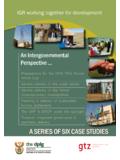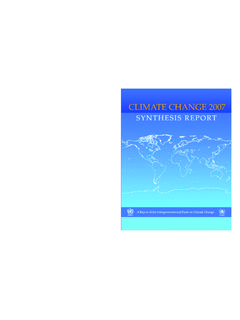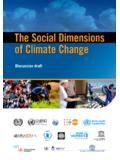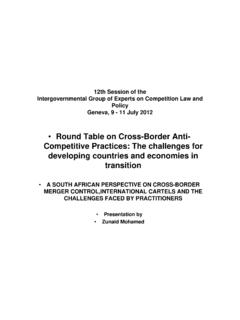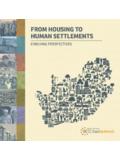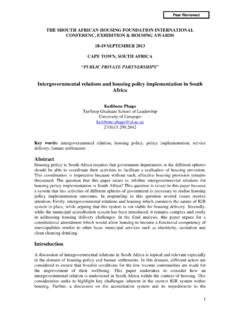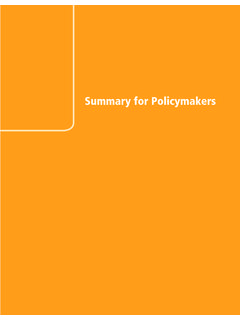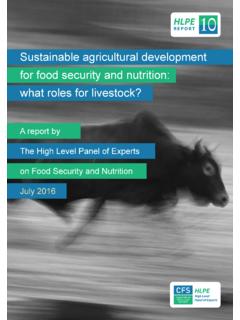Transcription of FAO Aquaculture Newsletter
1 September 2017. No 57. FA N. FAO Aquaculture Newsletter In this month's issue Nutrition Sensitive Aquaculture : a Dream or a Reality? ii Tilapia Lake Virus (TiLV) Caused by an Orthomyxo-like virus (Family Orthomyxoviridae) Threatening Cultured and Wild Stocks of Tilapia 9. Advancing Sustainable Aquaculture through Blue Growth 39. The Impact of Microplastics on Food Safety: the Case of Fishery and Aquaculture Products 43. INVITED. EDITORIAL form of DHA (docosahexaenoic acid) rather than ALA (a-Linolenic acid) is needed to secure an optimal brain development. This is particularly important during pregnancy and the first two years of life (the 1000-day window). WORLDFISH. Considering the past trends and experience in global fish production, R. SUBASINGHE. Woman feeding fish to her child in it is likely that the future demand for Bangladesh fish would be met by Aquaculture and the global per capita fish Nutrition Sensitive consumption may increase from current 21 kg to at least 23 kg per Aquaculture : year by 2025.
2 However, there are a few ethical issues. a Dream or a Reality? Some claim that, due to the high commodity value, there is a trend F ish provides more than billion people with at least 15 percent of their average per capita intake Fish is more than just a source of animal protein. It contains several essential amino acids, especially towards increasing production of shrimp in Asia (Asia contributes nearly 90 percent to the global of animal protein. Fish's unique lysine and methionine. The lipid Aquaculture production). They argue nutritional properties make it also composition of fish, with the that considering the increasing essential to the health of billions of presence of long-chain, poly- cost of fishmeal, which is a main consumers in both developed and unsaturated fatty acids (LC-PUFAs), ingredient for shrimp feed, there developing countries. Fish is one is unique. Fish is also an important is also a trend in sourcing fishmeal of the most efficient converters of source of essential micronutrients locally using small local species, feed into high quality food and its vitamins D, A and B, and minerals that would otherwise have been carbon footprint is lower compared (calcium, phosphorus, iodine, zinc, consumed directly by humans.)
3 To other animal production systems. iron and selenium), which makes it Small indigenous fish species, which Considering the increasing global particularly attractive in the current could be eaten whole and which population and importance of fight against malnutrition in low are very high in micronutrients feeding the future world with a income and food deficient countries such as vitamin A and B12, should heathy and nutritious diet, many (LIFDCs). Consumption of fish and not be used for making fishmeal have stressed that fish should be on especially oily fish is essential for an but be promoted as food and their everyone's plate. optimal development of the brain production should be increased, and neural system of our children, where appropriate. since omega-3 fatty acids in the The designations employed and the presentation of material in this FAO encourages the use, reproduction and dissemination of material information product do not imply the expression of any opinion whatsoever in this information product.
4 Except where otherwise indicated, material on the part of the Food and Agriculture Organization of the United Nations may be copied, downloaded and printed for private study, research and (FAO) concerning the legal or development status of any country, territory, teaching purposes, or for use in non-commercial products or services, city or area or of its authorities, or concerning the delimitation of its provided that appropriate acknowledgement of FAO as the source and frontiers or boundaries. The mention of specific companies or products of copyright holder is given and that FAO's endorsement of users' views, manufacturers, whether or not these have been patented, does not imply products or services is not implied in any way. that these have been endorsed or recommended by FAO in preference to others of a similar nature that are not mentioned. All requests for translation and adaptation rights, and for resale and other commercial use rights should be made via: The views expressed in this information product are those of the author(s) or addressed to and do not necessarily reflect the views or policies of FAO.
5 FAO information products are available on the FAO website FAO, 2017 ( ) and can be purchased through ii COVER PHOTOS: LEFT PHOTO: Fish hand fed at Yalelo Fish Farm in Lake Kariba, Zambia, R. BRUMMET RIGHT PHOTO: Feeding fish at Quatre Soeurs, Mauritius INVITED. EDITORIAL. A trade-off exists between export value and local nutrition. In several countries in Asia, particularly in Bangladesh and India, efforts are being made to improve household fish consumption through increase traditional homestead fish production. These efforts are providing convincing results and the interventions and principles are now proving successful and WORLDFISH. adaptable and/or repeatable in other countries. Bangladeshi woman showing small indigenous species, mola (Amblypharyngodon mola) cultured in her backyard pond A recent study1 focussing 41 nutritionally vulnerable nations alarming situation, especially when I truly believe nutrition sensitive (NVN), tried to find whether promoting fish as a nutritious Aquaculture can become a reality, Aquaculture meets human alternative to less healthier diets in if we make a paradigm shift nutritional demand directly via the world2.
6 In thinking from Aquaculture domestic production or trade, development to Aquaculture for or indirectly via purchase of These observations left should be sustainable development , using nutritionally rich dietary substitutes. pushing us rethink and redesign fish as the entry point to improve The study revealed that only a our strategies towards Aquaculture nutrition and livelihoods of target limited number of NVNs have development worldwide. Is the communities consisting billions of domestically farmed fish, and of notion of nutrition sensitive people worldwide. We need the those, only specific Aquaculture Aquaculture , a dream or reality? political will! approaches ( freshwater) in Thinking positively with some some locations have the potential experiences from several NVNs, to benefit nutritionally vulnerable populations. In other words, high 2 Citation: Bogard JR, Farook S, Marks GC, Waid J, Belton B, Ali M, et al. (2017) Higher value farmed fish always find a fish but lower micronutrient intakes: market outside the location of Temporal changes in fish consumption Rohana Subasinghe from capture fisheries and Aquaculture in production.
7 Bangladesh. PLoS ONE 12(4): e0175098. Former Head of FAO Aquaculture Branch E-mail: It has also been found, in some parts of Bangladesh, increased availability of cultured freshwater fish has increased consumption of fish in rural households, although consumption of traditional small indigenous species with superior nutritional qualities has been reduced significantly. This is an 1 Golden, , Seto, , Dey, ,Chen, , Gephart, , Myers, , Smith, M., Vaitla, B. & Allison, 2017. FAO/V. CRESPI. Does Aquaculture Support the Needs of Nutritionally Vulnerable Nations? Front. Mar. Sci. 4:159. doi: Woman selling smoked North African catfish outside Albert Market in Banjul, Gambia FAO Aquaculture Newsletter No. 57 SEPTEMBER 2017 iii CONTENTS. Invited Editorial Nutrition Sensitive Aquaculture : a Dream or a Reality? ii Aquaculture UPDATES. FAO/A. NESAR. BY REGION 15. GLOBAL Aquaculture . UPDATES 7 Asia-Pacific Harvesting of striped catfish (Pangasius Regional Consultation on Responsible hypophthalmus) from an hearthen pond in From the Statistician's Desk Production and Use of Feed and Feed Bangladsh Considerations from the Aquaculture Ingredients for Sustainable Growth of Statisticians 7 Aquaculture in Asia-Pacific 15.
8 From Fish Health Specialist's Ensuring sustainable expansion of Near East and North Africa Desk Support to the National Agency for Aquaculture in Bangladesh 17. Tilapia Lake Virus (TiLV) Caused the Development of Aquaculture by an Orthomyxo-like virus (ANDA) in Morocco 24. Highlight of Aquaculture Focused (Family Orthomyxoviridae) Threatening Country Projects (TCPs) in Asia-Pacific 19. Cultured and Wild Stocks of Tilapia 9 Ninth Session of the Regional Commission for Fisheries (RECOFI) 25. Regional Initiative to Promote Scaling Meetings/events up of Innovative Agro- Aquaculture Outcomes of the COFI-Sub-Committee and Climate Resilient Tilapia Farming Latin America and the on Fish Trade 12 Practices 21. Caribbean Aquaculture Expansion in a Landlocked Country, the Case of FAO Supported the World Aquaculture Europe 2017 Conference in Cape Town, South Paraguay 27. International Conference on Maritime Africa 13 Spatial Planning, Ecosystem Approach Adaptation of Fisheries and and Supporting Information Systems 22.
9 Conference-Dialogue on Blue Growth Aquaculture to Climate Change in and Economy: Sharing Perspectives and Chile 29. European Fisheries and Aquaculture Experiences for Africa 14 Forum 2017 23. Results of a Regional Workshop on Occupational Security for Diving Fishers in Latin America: Towards Decent Rural Employment 31. Sub-Saharan Africa Financing African Aquaculture for Sustainable Economic Development 32. Seventeenth Session of the Committee on Inland Fisheries and Aquaculture of Africa (CIFAA) 34. Fish and Cassava Stop Migration in Guinea-Bissau 35. FAO/A. NESAR. Freshwater prawns (Macrobrachium rosenbergii) are selling on a street market in Bangladesh iv FAO Aquaculture Newsletter No. 57 SEPTEMBER 2017. CONTENTS. FAO/A. STANKUS. American bullfrogs are intensively grown in an Aquaculture facility in Hong He County, China PR. NEW STAFF PROFILES 52. Nigeria: Faster Aquaculture Growth Needed to Bridge Fish Demand-Supply Gap 36 NEW PUBLICATIONS 53. The Regional Capacity Building Workshop on Aquaculture Models CALENDAR OF EVENTS 61.
10 And Technologies to Reduce Poverty, Improve Youth Employment and Promote Commercialization 38. THEMATIC ARTICLES 39. Advancing Sustainable Aquaculture through Blue Growth 39. The Impact of Microplastics on Food Safety: the Case of Fishery and Aquaculture Products 43. Aquaculture in Small Islands Development States (SIDS) 46. Aquaculture Growth Potential: Perspective from Short-Term Projection of Fish Demand 48. MISCELLANEOUS 49. Updates on Antimicrobial Resistance (AMR) 49. Summary of National FAO/M. LEDO. Aquaculture Legislation Overview (NALO) of Morocco 51. Seaweed farmers carrying seaweed seedlings, Indonesia FAO Aquaculture Newsletter No. 57 SEPTEMBER 2017 v T he FAO Committee on Fisheries (COFI), Sub-Committee on Aquaculture (SCA) provides a forum for consultation and discussion on Aquaculture and advises COFI on technical and policy matters related to Aquaculture and on the work to be performed by FAO in the subject matter field of Aquaculture . The First session of the COFI-SCA took place in Beijing, China in 2002.










